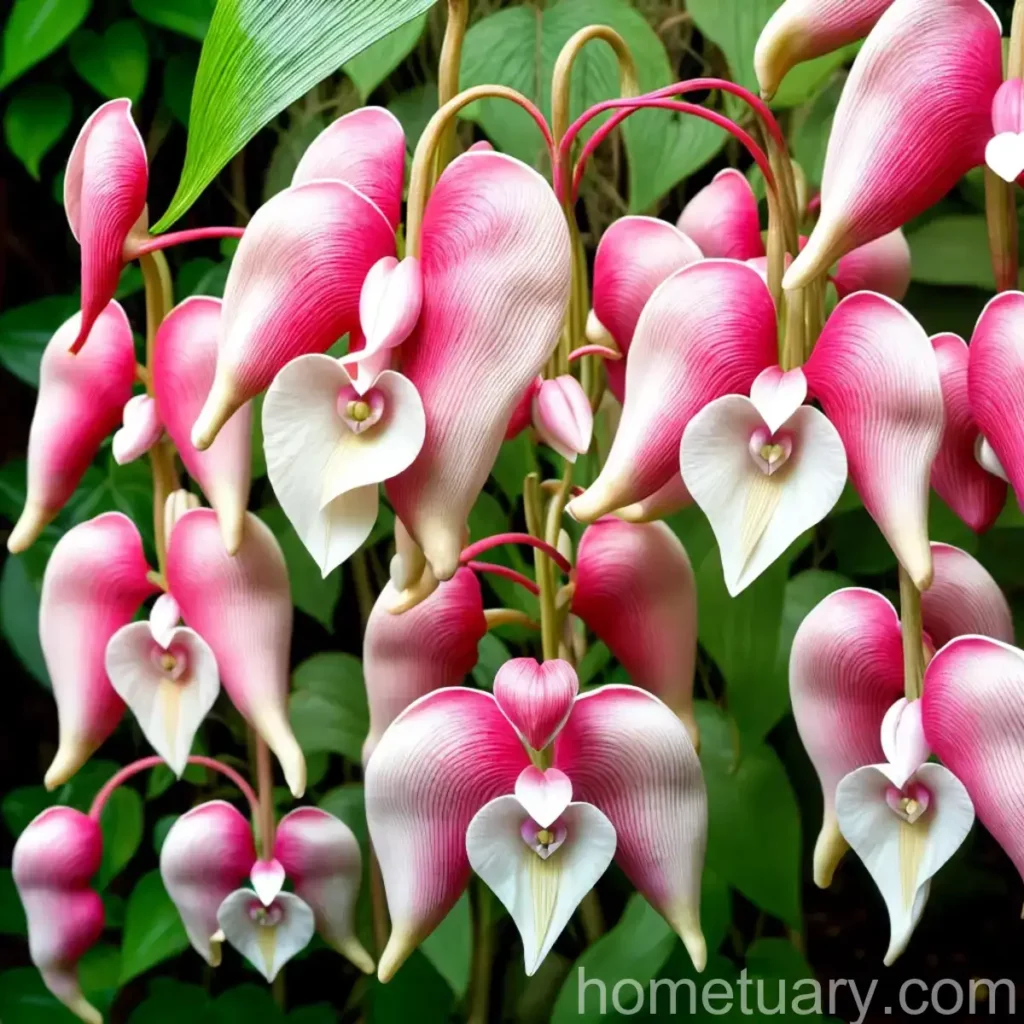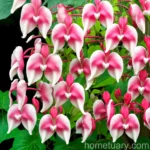Bleeding Heart (Lamprocapnos spectabilis ‘Gold Heart’)
Introduction
The Bleeding Heart (Lamprocapnos spectabilis ‘Gold Heart’) is a stunning and unique perennial plant known for its heart-shaped flowers and foliage. The ‘Gold Heart’ variety is a cultivar that adds a vibrant twist to the traditional bleeding heart plant, with its golden-yellow foliage creating a striking contrast against the arching stems and pink heart-shaped flowers. This cultivar has gained popularity for its ornamental value and shade-loving nature, making it a favorite among gardeners and landscape enthusiasts.
In this comprehensive guide, we will delve into the culture, uses, care requirements, and propagation techniques for the Bleeding Heart (Lamprocapnos spectabilis ‘Gold Heart’), along with insights into its popularity, common diseases, pests, and maintenance tips.
Key Takeaways – Bleeding Heart (Lamprocapnos spectabilis ‘Gold Heart’)
Before we delve into the intricate details of the Bleeding Heart (Lamprocapnos spectabilis ‘Gold Heart’), let’s take a quick look at the key takeaways for this unique and captivating plant:
- Common Name: Bleeding Heart (Lamprocapnos spectabilis ‘Gold Heart’)
- Botanical Name: Lamprocapnos spectabilis ‘Gold Heart’
- Variety: Gold Heart
- Features: Heart-shaped flowers and leaves, golden-yellow foliage
- Type: Perennial
- Shade Preference: Shade-loving plant
- Characteristics: Ornamental plant, showy flowers
- Uses: Landscaping, garden borders, shaded areas
- Care: Low maintenance, water and shade requirements
- Propagation: Seeds, division
- Popularity: Attractive and unique cultivar
- Disease Resistance: Resistant to some common diseases
- Pest Management: Susceptible to certain pests
- Tips: Soil, pruning, and maintenance insights
- Fun Facts: Intriguing details and folklore surrounding the plant
Now, let’s deep dive into the various aspects of the Bleeding Heart (Lamprocapnos spectabilis ‘Gold Heart’) to understand its culture, uses, care requirements, and much more.
Culture
The culture of the Bleeding Heart (Lamprocapnos spectabilis ‘Gold Heart’) encompasses its growth habits, preferred conditions, and overall suitability for different environments. Understanding the culture of this plant is essential for successful cultivation and maintenance.
Water
The Bleeding Heart (Lamprocapnos spectabilis ‘Gold Heart’) thrives in moist, well-draining soil. Adequate moisture is crucial for the plant, especially during the growing season and hot summer months. Regular watering is essential to keep the soil consistently moist but not waterlogged. However, it is essential to avoid overwatering, as excessively wet conditions can lead to root rot and other water-related issues.
Sunlight
As a shade-loving plant, the Bleeding Heart (Lamprocapnos spectabilis ‘Gold Heart’) prefers partial to full shade. While it can tolerate some morning sun, it generally thrives in locations with filtered light or dappled shade. Planting in a location with indirect sunlight or gentle morning sun is ideal for promoting healthy growth and vibrant foliage.
Fertilizer
When it comes to fertilizing the Bleeding Heart (Lamprocapnos spectabilis ‘Gold Heart’), a balanced, all-purpose fertilizer can be applied in early spring as new growth emerges. A slow-release granular fertilizer or a liquid fertilizer diluted to half strength can provide the necessary nutrients to support healthy foliage and flower production. It is important to follow the recommended application rates and avoid over-fertilization, which can lead to excessive vegetative growth at the expense of flowers.
Soil
The ideal soil conditions for the Bleeding Heart (Lamprocapnos spectabilis ‘Gold Heart’) consist of rich, organic, and well-draining soil. A loamy soil texture with ample organic matter offers the best growing medium for this plant. Additionally, maintaining a slightly acidic to neutral soil pH within the range of 6.0 to 7.0 supports optimal nutrient uptake and overall plant health.
Pruning
Pruning the Bleeding Heart (Lamprocapnos spectabilis ‘Gold Heart’) is essential to maintain its shape, remove spent flowers, and promote vigorous growth. Here are some key pruning techniques for this plant:
- Deadheading: Remove faded flowers to encourage continuous blooming and prevent self-seeding.
- Spring Pruning: In early spring, trim back any damaged or winter-killed stems to encourage new growth.
- Dividing: Every three to four years, consider dividing mature clumps in early spring to rejuvenate the plant and maintain its vigor.
Care should be taken while pruning to avoid damaging the delicate stems and foliage of the Bleeding Heart (Lamprocapnos spectabilis ‘Gold Heart’). Sharp, clean pruners should be used to make precise cuts without causing unnecessary harm to the plant.
Propagation
Propagating the Bleeding Heart (Lamprocapnos spectabilis ‘Gold Heart’) can be accomplished through seeds and division. Here’s how you can propagate this unique plant:
- Seed Propagation: Collect ripe seeds in late summer or early fall, and sow them in prepared soil in a shaded area. Keep the soil consistently moist, and the seeds should germinate within a few weeks.
- Division: In early spring or after the flowering season, carefully divide established clumps, ensuring that each division has sufficient roots and foliage. Plant the divisions in a suitable location with adequate shade and moisture.
By following these propagation methods, you can expand your collection of Bleeding Heart (Lamprocapnos spectabilis ‘Gold Heart’) plants and share their beauty with fellow gardening enthusiasts.
Container Popularity
The Bleeding Heart (Lamprocapnos spectabilis ‘Gold Heart’) has gained popularity as a container plant due to its unique foliage and charming flowers. Planting this cultivar in containers allows for greater flexibility in creating striking garden displays and provides the opportunity to showcase its distinct features in various settings.
Container Common Diseases
When growing the Bleeding Heart (Lamprocapnos spectabilis ‘Gold Heart’) in containers, it is important to be mindful of potential diseases that may affect the plant. While container cultivation offers certain advantages, such as controlled conditions and portability, it also presents challenges related to soil moisture, nutrient availability, and disease management.
Disease Diagnosis
Some common diseases that may affect Bleeding Heart (Lamprocapnos spectabilis ‘Gold Heart’) in containers include:
- Root Rot: Excessive moisture in container soil can lead to root rot, resulting in wilting, yellowing foliage, and stunted growth.
- Powdery Mildew: Under humid and poorly ventilated conditions, powdery mildew may appear as a white, powdery coating on the leaves, affecting the plant’s overall health and appearance.
Vigilant monitoring of container-grown Bleeding Heart (Lamprocapnos spectabilis ‘Gold Heart’) is essential to identify and address any signs of disease promptly. Proper watering practices, adequate air circulation, and preventive measures can help mitigate the risk of disease development in container plants.
Disease Management
To manage and prevent diseases in container-grown Bleeding Heart (Lamprocapnos spectabilis ‘Gold Heart’), consider the following strategies:
- Well-Draining Soil: Use a well-draining potting mix to minimize the risk of waterlogging and root rot.
- Adequate Air Circulation: Position containers in areas with good air circulation to reduce humidity and minimize the potential for powdery mildew.
- Sanitation: Regularly remove any fallen or diseased foliage from the containers and surrounding areas to prevent the spread of diseases.
By implementing these disease management practices, you can help maintain the health and vitality of Bleeding Heart (Lamprocapnos spectabilis ‘Gold Heart’) plants grown in containers.
Common Pests
Like many plants, the Bleeding Heart (Lamprocapnos spectabilis ‘Gold Heart’) is susceptible to certain pests that can affect its growth and overall well-being. Understanding the common pests and adopting effective pest management strategies is crucial for preserving the beauty of this captivating plant.
Some common pests that may pose a threat to the Bleeding Heart (Lamprocapnos spectabilis ‘Gold Heart’) include:
- Aphids: These small, soft-bodied insects may cluster on the undersides of leaves, sucking sap from the plant and causing distortion of foliage.
- Slugs and Snails: These mollusks can feed on the tender foliage of the Bleeding Heart, leaving behind distinctive holes and damage.
- Verticillium Wilt: A fungal disease that can affect the plant’s vascular system, causing wilting, yellowing, and eventual decline.
Implementing pest management strategies such as handpicking, natural predators, and organic controls can help mitigate pest infestations and reduce the impact on Bleeding Heart (Lamprocapnos spectabilis ‘Gold Heart’) plants. Additionally, maintaining a healthy growing environment and promptly addressing any pest issues can contribute to the long-term vitality of the plant.
Botanist’s Tips
As a plant scientist deeply passionate about botanical wonders, I am delighted to share some expert tips for cultivating and managing the Bleeding Heart (Lamprocapnos spectabilis ‘Gold Heart’):
- Shade Considerations: When selecting a planting site, prioritize locations with filtered shade or partial shade to create an optimal environment for the Bleeding Heart.
- Mulching: Apply a layer of organic mulch around the base of the plant to conserve soil moisture, suppress weeds, and provide insulation.
- Companion Planting: Pair the Bleeding Heart with complementary shade-loving plants such as hostas, ferns, and astilbes to create visually appealing and harmonious garden compositions.
- Garden Design: Incorporate the unique foliage and heart-shaped flowers of the Bleeding Heart into woodland gardens, shaded borders, and mixed perennial beds for an enchanting and distinctive display.
- Watering Technique: To maintain consistent soil moisture, use a soaker hose or drip irrigation system to deliver water directly to the root zone without wetting the foliage excessively.
By integrating these botanist’s tips into your approach to cultivating the Bleeding Heart (Lamprocapnos spectabilis ‘Gold Heart’), you can enhance the plant’s performance, resilience, and aesthetic impact in the garden.
Fun Facts
Here are some fascinating and intriguing fun facts about the Bleeding Heart (Lamprocapnos spectabilis ‘Gold Heart’):
- The Bleeding Heart plant has a rich folklore associated with its unique heart-shaped flowers, often symbolizing love, compassion, and romantic enchantment.
- While the traditional Bleeding Heart plant features pink flowers and green foliage, the ‘Gold Heart’ variety introduces a captivating twist with its golden-yellow foliage, adding a touch of elegance to garden landscapes.
- The genus name “Lamprocapnos,” derived from the Greek words “lampros” (bright) and “kapnos” (smoke), reflects the radiant and ethereal qualities of the plant’s flowers and overall appearance.
These fun facts add intrigue and depth to the allure of the Bleeding Heart (Lamprocapnos spectabilis ‘Gold Heart’), capturing the imagination of gardening enthusiasts and nature lovers alike.
Links to External Resources
As you continue to explore the captivating world of the Bleeding Heart (Lamprocapnos spectabilis ‘Gold Heart’), I encourage you to delve deeper into valuable external resources that offer additional insights, guidance, and inspiration:
- Royal Horticultural Society – Bleeding Heart Plant Profile
- North Carolina State University Extension – Growing Bleeding Hearts
- The Morton Arboretum – Lamprocapnos spectabilis Profile
- University of Maryland Extension – Dicentras: Old-fashioned Charmers for the Shade Garden
These reputable sources offer a wealth of information on plant care, botanical characteristics, and creative applications of the Bleeding Heart (Lamprocapnos spectabilis ‘Gold Heart’), enriching your journey as a dedicated gardener and plant enthusiast.
In conclusion, the Bleeding Heart (Lamprocapnos spectabilis ‘Gold Heart’) captivates us with its alluring blend of heart-shaped flowers, golden-yellow foliage, and ornamental charm. By embracing its unique culture, understanding its care requirements, and appreciating its botanical significance, we can celebrate the enduring beauty and enchanting presence of this perennial treasure in our gardens and landscapes.
As a Plant Scientist, I thoroughly enjoyed the opportunity to delve into the captivating world of the Bleeding Heart (Lamprocapnos spectabilis ‘Gold Heart’) and share comprehensive insights on its culture, uses, care, and more. This extensive guide aims to provide valuable information for plant enthusiasts, gardeners, and nature lovers who are drawn to the intriguing allure of this exceptional perennial plant. If you have any additional questions about the Bleeding Heart or other plant species, feel free to reach out for expert guidance and assistance.















